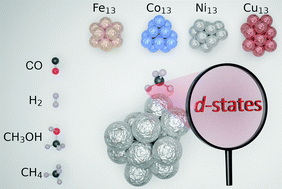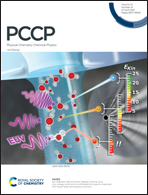Ab initio investigation of the role of the d-states occupation on the adsorption properties of H2, CO, CH4 and CH3OH on the Fe13, Co13, Ni13 and Cu13 clusters†
Abstract
Here, we report a theoretical investigation, based on density functional theory calculations, into the role of the occupation d-states on the adsorption properties of CH4, CO, H2 and CH3OH on 3d 13-atom transition-metal (TM13) clusters (TM = Fe, Co, Ni, Cu). Except for Cu13, a gradual increase in the occupation of the d-states, i.e., from Fe13 to Ni13, increases the magnitude of the adsorption energy almost linearly for the H2/TM13 and CO/TM13 systems, which can be explained by the enhancement of the sp–d hybridization due to the shift of the d-states towards the highest occupied molecular orbital (HOMO). For Cu13, the d-states are located well below the HOMO, which reduces the sp–d hybridization, and hence, a smaller adsorption energy is obtained. However, this picture does not hold for CH4/TM13 and CH3OH/TM13, where the adsorption energy has nearly the same value for all TM13 clusters, which can be explained by electrostatic effects such as local polarization of the molecules and nearby TM atoms, and hence, the basic features of physisorption systems. Based on the electron density difference, the polarization effects are slightly larger for systems with empty d-states.



 Please wait while we load your content...
Please wait while we load your content...